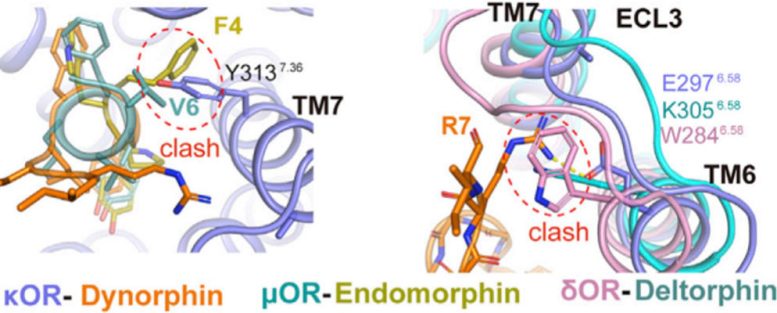A group of scientists collaborated to release comprehensive structures of the entire human opioid receptor family, with the aim of facilitating the development of more precise pain medications.
In an ongoing endeavor to enhance opioid pain medications, scientists from the United States and China utilized cryoEM technology to determine the comprehensive structures of the entire family of opioid receptors when bound to their natural peptides. Further structure-informed biochemical studies were conducted to gain a deeper comprehension of the peptide-receptor selectivity and drug signaling mechanisms.
The findings, published in the journal Cell, offer a comprehensive structural framework that should assist drug developers in creating safer drugs for the alleviation of severe pain.
Opioid drugs relieve pain by mimicking a naturally occurring pain-relief function within our nervous symptoms. They are the best, strongest pain relievers we have. Unfortunately, they come with side effects, some severe such as numbness, addiction, and respiratory depression, leading to overdose deaths.

Alignment of peptide-bound opioid receptors reveals structural features, such as steric effects, that contribute to the subtype-selective binding and functional outcomes observed in biochemical assays. Credit: Roth Lab, UNC School of Medicine
Scientists have been trying for many years to overcome the side-effect problem in various ways, all involving one or more of four opioid receptors to no avail. One way scientists continue to explore is the creation of peptide or peptide-inspired small molecule drugs.
Peptides are short chains of amino acids; think of them as short proteins. Certain naturally occurring, or endogenous, peptides bind to opioid receptors on the surface of cells to create an analgesic effect, also known as pain relief. Think of an analgesic like an anesthetic, except that analgesics do not "turn off" the nerves to numb the body or alter consciousness. So, the idea is to create a peptide drug that has a strong analgesic effect, without numbing nerves or altering consciousness, or causing digestive, respiratory, or addiction issues.
"The problem in the field is we've lacked the molecular understanding of the interplay between opioid peptides and their receptors," said Roth, co-senior author and the Michael Hooker Distinguished Professor of Pharmacology. "We've needed this understanding in order to try to rationally design potent and safe peptide or peptide-inspired drugs."
Using cryogenic electron microscopy, or cryoEM, and a battery of biomechanistic experiments in cells, the Xu and Roth labs systematically solved the detailed structures of endogenous peptides bound to all four opioid receptors. These structures revealed details and insights into how specific naturally occurring opioid peptides selectively recognize and activate opioid receptors. The researchers also used exogenous peptides, or drug-like compounds, in some of their experiments to learn how they activate the receptors.
The cryoEM structures of agonist-bound receptors in complex with their G protein effectors (called their "active state") represent what these receptors look like when they are signaling in cells, giving a detailed view of peptide-receptor interactions. The Roth lab used the structures solved by the Xu lab to guide the design of mutant receptors and then tested these receptors in biochemical assays in cells to determine how they alter receptor signaling. Understanding these interactions can then be used to design drugs that are selective for opioid receptor subtypes, as well as to produce certain signaling outcomes that may be more beneficial than those of conventional opioids.
"This collaboration revealed conserved, or shared, mechanisms of activation and recognition of all four opioid receptors, as well as differences in peptide recognition that can be exploited for creating subtype-selective drugs," said DiBerto, first author and Ph.D. candidate in the Roth lab. "We provide more needed information to keep pushing the field forward, to answer basic science questions we hadn't been able to answer before now."
Previous research showed the structure of opioid receptors in their inactive or active-like states, with active state structures only existing for the mu-opioid receptor subtype, the primary target of drugs like fentanyl and morphine. In the Cell paper, the authors show agonist-bound receptors in complex with their G protein effectors, made possible through cryoEM technology that did not exist when currently used medications were being developed.
Drugs such as oxycontin, oxycodone, and morphine cause various effects inside cells and throughout the nervous symptom, including pain relief. But they have effects in the digestive and respiratory systems, too, and interact with cells to lead to addiction. Fentanyl, meanwhile, is another powerful pain reliever, but it binds to opioid receptors in such a way as to cause severe side effects, including the shutdown of the respiratory system.
The thrust behind such research led by Xu and Roth is to home in on the mechanistic reasons for pain relief potency without triggering the cellular mechanisms that lead to severe side effects and overdosing.
"We are attempting to build a better kind of opioid," Roth says, "We're never going to get there without these kind of basic molecular insights, wherein we can see why pain is relieved and why side effects occur."
News
Deadly Hospital Fungus May Finally Have a Weakness
A deadly, drug-resistant hospital fungus may finally have a weakness—and scientists think they’ve found it. Researchers have identified a genetic process that could open the door to new treatments for a dangerous fungal infection [...]
Fever-Proof Bird Flu Variant Could Fuel the Next Pandemic
Bird flu viruses present a significant risk to humans because they can continue replicating at temperatures higher than a typical fever. Fever is one of the body’s main tools for slowing or stopping viral [...]
What could the future of nanoscience look like?
Society has a lot to thank for nanoscience. From improved health monitoring to reducing the size of electronics, scientists’ ability to delve deeper and better understand chemistry at the nanoscale has opened up numerous [...]
Scientists Melt Cancer’s Hidden “Power Hubs” and Stop Tumor Growth
Researchers discovered that in a rare kidney cancer, RNA builds droplet-like hubs that act as growth control centers inside tumor cells. By engineering a molecular switch to dissolve these hubs, they were able to halt cancer [...]
Platelet-inspired nanoparticles could improve treatment of inflammatory diseases
Scientists have developed platelet-inspired nanoparticles that deliver anti-inflammatory drugs directly to brain-computer interface implants, doubling their effectiveness. Scientists have found a way to improve the performance of brain-computer interface (BCI) electrodes by delivering anti-inflammatory drugs directly [...]
After 150 years, a new chapter in cancer therapy is finally beginning
For decades, researchers have been looking for ways to destroy cancer cells in a targeted manner without further weakening the body. But for many patients whose immune system is severely impaired by chemotherapy or radiation, [...]
Older chemical libraries show promise for fighting resistant strains of COVID-19 virus
SARS‑CoV‑2, the virus that causes COVID-19, continues to mutate, with some newer strains becoming less responsive to current antiviral treatments like Paxlovid. Now, University of California San Diego scientists and an international team of [...]
Lower doses of immunotherapy for skin cancer give better results, study suggests
According to a new study, lower doses of approved immunotherapy for malignant melanoma can give better results against tumors, while reducing side effects. This is reported by researchers at Karolinska Institutet in the Journal of the National [...]
Researchers highlight five pathways through which microplastics can harm the brain
Microplastics could be fueling neurodegenerative diseases like Alzheimer's and Parkinson's, with a new study highlighting five ways microplastics can trigger inflammation and damage in the brain. More than 57 million people live with dementia, [...]
Tiny Metal Nanodots Obliterate Cancer Cells While Largely Sparing Healthy Tissue
Scientists have developed tiny metal-oxide particles that push cancer cells past their stress limits while sparing healthy tissue. An international team led by RMIT University has developed tiny particles called nanodots, crafted from a metallic compound, [...]
Gold Nanoclusters Could Supercharge Quantum Computers
Researchers found that gold “super atoms” can behave like the atoms in top-tier quantum systems—only far easier to scale. These tiny clusters can be customized at the molecular level, offering a powerful, tunable foundation [...]
A single shot of HPV vaccine may be enough to fight cervical cancer, study finds
WASHINGTON -- A single HPV vaccination appears just as effective as two doses at preventing the viral infection that causes cervical cancer, researchers reported Wednesday. HPV, or human papillomavirus, is very common and spread [...]
New technique overcomes technological barrier in 3D brain imaging
Scientists at the Swiss Light Source SLS have succeeded in mapping a piece of brain tissue in 3D at unprecedented resolution using X-rays, non-destructively. The breakthrough overcomes a long-standing technological barrier that had limited [...]
Scientists Uncover Hidden Blood Pattern in Long COVID
Researchers found persistent microclot and NET structures in Long COVID blood that may explain long-lasting symptoms. Researchers examining Long COVID have identified a structural connection between circulating microclots and neutrophil extracellular traps (NETs). The [...]
This Cellular Trick Helps Cancer Spread, but Could Also Stop It
Groups of normal cbiells can sense far into their surroundings, helping explain cancer cell migration. Understanding this ability could lead to new ways to limit tumor spread. The tale of the princess and the [...]
New mRNA therapy targets drug-resistant pneumonia
Bacteria that multiply on surfaces are a major headache in health care when they gain a foothold on, for example, implants or in catheters. Researchers at Chalmers University of Technology in Sweden have found [...]





















